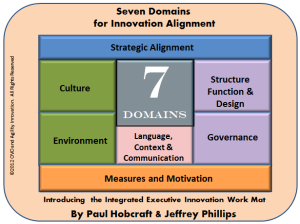I’ve had one of those weeks where a certain realization took hold, something that had been nagging away at you suddenly surfaces and slaps you in the face. Ouch!
I have just completed my own gap analysis on how I have explained the Executive Innovation Work Mat methodology and its value. It actually was a bit of an eye-opener. I was surprised in this audit of all associated posts, articles and papers written by myself or in collaboration with Jeffrey Phillips, that there were some very glaring gaps in my posts on explaining this methodology.

The Innovation Work Mat has seven components or domains
What was crazy here is the fact I have the research, the component parts all worked through, structured and being used in actual engagements to prompt the essential discussions, yet I had not been publishing these enough through my posts to underpin the methodology.
I had been missing essential domain component messages that are the very essence of why you need to work around the entire work mat as essential. I was missing the opportunity to publically talk about ALL the parts as it is the combining of these that does provide its value as an integrated approach to innovation that can cascade throughout the organization.
Continue reading “Correcting an innovation oversight sometimes hits you hard!”







